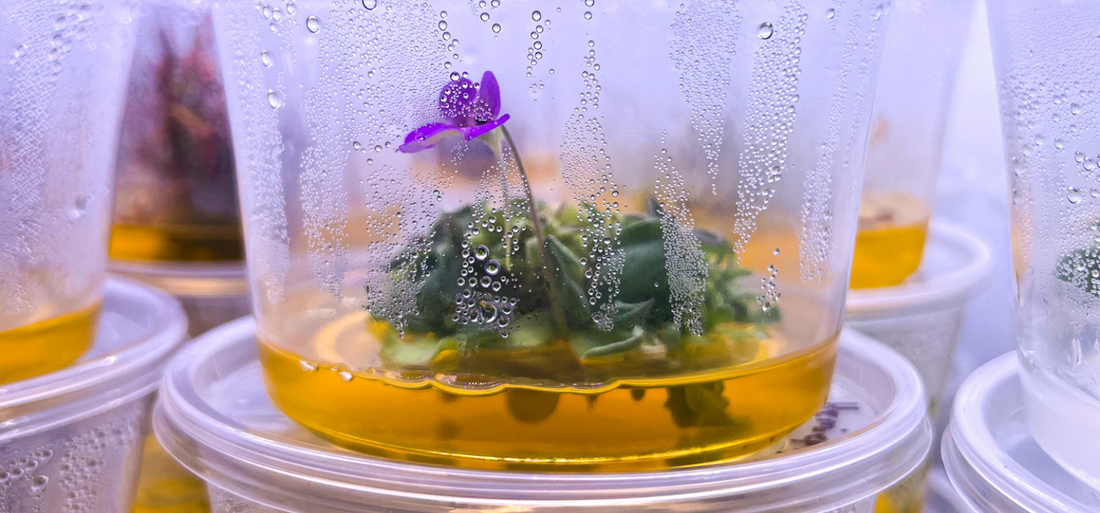
How Tissue Culture is Transforming Flower Production?
As a content and community manager, I leverage my expertise in plant biotechnology, passion for tissue culture, and writing skills to create compelling articles, simplifying intricate scientific concepts, and address your inquiries. As a dedicated science communicator, I strive to spark curiosity and foster a love for science in my audience.


Introduction
Flowers have captivated human civilization for centuries, serving as symbols of love, beauty, and cultural significance.
The global floriculture industry, which encompasses the cultivation, production, and trade of flowers and ornamental plants, has seen remarkable growth due to increasing demand for flowers in various sectors.
However, meeting this rising demand poses several challenges, including climate variability, disease outbreaks, and the need for high-quality, uniform plants.
Tissue culture, a revolutionary biotechnology, has emerged as a game-changer in addressing these challenges, offering a sustainable and efficient approach to large-scale flower production.
In this article, we talk about the floriculture industry, its expanding market, traditional approaches, tissue culture techniques, and innovations underway to solve current challenges.

The Growing Importance of the Flower Industry
Floriculture is a thriving segment of horticulture, encompassing the commercial production of flowers, potted plants, cut foliage, and ornamental species. It plays a crucial role in multiple industries, including:
-
Decorative and Landscaping: Flowers are widely used in home gardens, public parks, and urban landscapes, enhancing aesthetic appeal.
-
Emotional Expression: Flowers are often used to convey emotions like love, sympathy, congratulations, and gratitude.
-
Floral Trade: The cut flower market, driven by events such as weddings, festivals, and corporate functions, generates significant revenue worldwide.
-
Fragrance and Essential Oils: Many flowers like roses, jasmine, and lavender are cultivated for perfumes and therapeutic applications.
-
Pharmaceutical and Medicinal Use: Some floricultural plants possess medicinal properties and are used in herbal remedies.
-
Export Industry: Countries like the Netherlands, Colombia, and Kenya dominate the flower export business, supplying high-quality blooms to global markets.
With an ever-expanding market, floriculture presents lucrative opportunities. However, traditional cultivation methods face several limitations, making it imperative to adopt innovative techniques such as plant tissue culture.
This industry is experiencing rapid global growth, with a high compound annual growth rate, creating lucrative professional opportunities. The increasing international demand for novel flower varieties makes tissue culture especially important.

Challenges in Commercial Flower Cultivation
Traditionally, flowers have been propagated through methods like seed sowing, cuttings, grafting, and division. The large-scale production of flowers comes with inherent difficulties that threaten the industry's sustainability:
-
Propagation Limitations: Many ornamental plants have slow growth rates, low seed viability, or inefficient propagation methods. Traditional seed propagation is often undesirable due to cross-pollination, resulting in variable offspring. Seed germination can also be problematic due to poor viability, small seed size, and limited endosperm. Standard vegetative propagation methods are often too slow to keep pace with growing demand.
-
Pest and Disease Management: Flowers are highly susceptible to fungal, bacterial, and viral infections, which can drastically reduce yields.
-
Climate Dependency: Traditional farming is vulnerable to unpredictable weather conditions, affecting plant growth and bloom cycles.
-
Quality Consistency: Maintaining uniformity in flower color, size, and shape is a challenge when relying on conventional propagation.
-
Land and Resource Constraints: Increasing urbanization has led to limited agricultural land, pushing the need for high-density, efficient growing methods.
Given these constraints, tissue culture has emerged as a promising solution to transform flower production.
Plant Tissue Culture: A Boon for the Flower Industry
Tissue culture, also known as micropropagation, is a modern biotechnological method that enables the rapid and controlled propagation of plants under sterile conditions.
This technique is widely adopted in floriculture to enhance production efficiency, improve plant quality, and ensure genetic conservation.

Here’s how tissue culture is revolutionizing the flower industry:
1. Mass Production of High-Quality Plants
Tissue culture allows for the large-scale propagation of flowers with identical traits. Using explants (such as shoot tips or leaf segments), scientists can produce thousands of clones in a short period, ensuring genetic uniformity and superior quality. This ensures a consistent supply of high-quality planting material and enables uniform production year-round, even for seasonal crops.
2. Disease-Free and Pest-Resistant Plants
One of the biggest challenges in floriculture is managing diseases and pests. Tissue culture provides a solution by generating disease-free plants through meristem culture, which involves culturing the shoot apex. This allows for the production of virus-free plants and germplasm. These pathogen-free plants significantly reduce the risk of contamination, leading to healthier crops and lower pesticide usage.
3. Year-Round Production and Climate Independence
Unlike traditional farming, which depends on seasonal conditions, tissue culture allows for year-round flower production in controlled environments. This method ensures continuous supply regardless of external climate fluctuations, benefiting commercial growers and exporters.
4. Faster Growth and Improved Yield
Flowers produced through tissue culture exhibit rapid growth and early flowering due to controlled conditions optimized for nutrients, temperature, and light exposure. This accelerated development reduces production cycles and enhances growers' profitability.
5. Genetic Improvement and Conservation
Tissue culture plays a vital role in conserving rare and endangered floral species by preserving their genetic makeup. Additionally, it aids in breeding new flower varieties with enhanced traits such as vibrant colors, extended shelf life, and improved fragrance.
6. Space and Resource Efficiency
Since tissue culture requires minimal land compared to conventional farming, it is a viable solution for urban floriculture and vertical farming. Controlled environments also optimize resource utilization, reducing water consumption and fertilizer dependency.

Tissue Culture Techniques for Floriculture or Flower Propagation
Several tissue culture methods are employed to enhance flower production:
-
Micropropagation:
-
This is the most common technique used for rapid clonal multiplication of plants. It involves culturing shoot tips, axillary buds, or other plant parts to produce multiple identical plants.
-
Vegetative propagation methods often struggle to keep up with demand, particularly for species like orchids and anthuriums, which propagate slowly and may take a considerable amount of time to flower again after division.
-
Tissue culture offers a solution for the rapid multiplication of these and other floricultural crops.
-
Micropropagation is also the main system used to clonally propagate orchids, gerberas, and lilies due to their high economic value. Research continues to refine micropropagation protocols for increased efficiency and to ensure the health and phenotypic fidelity of the produced plants, often derived from conventional breeding or techniques like colchicine treatment.
-
This large-scale production leads to more uniform crop growth, improving cutting times and optimizing production management. Studies range from seed disinfection methods (e.g., Lilium longiflorum) to growth regulator effects, explant types, and acclimatization techniques.
-
-
Callus Culture:
-
Callus, an undifferentiated mass of plant cells, can be induced from various plant tissues. Callus culture can be used for the regeneration of whole plants or for genetic transformation studies.
-
-
Suspension Culture:
-
Plant cells are grown in a liquid medium. Suspension cultures can be used for the production of secondary metabolites or for genetic transformation.
-
-
Somatic Embryogenesis:
-
Facilitates in large-scale production through embryo-like structures, especially in commercial crops like carnations. Artificial seeds are encapsulated somatic embryos that can be used as seeds and possess the ability to convert into plants under in vitro or ex-vitro conditions.
-
Synthetic seeds have a high volume, and they maintain the genetic uniformity of plants. It can be used for large-scale monoculture and in floricultural crops that do not produce seeds or have difficulties with seed propagation.
-
-
Anther/Microspore Culture:
-
These techniques involve culturing anthers or microspores (immature pollen grains) to produce haploid plants, which can be valuable for breeding programs.
-
Protoplast Fusion: Used to create hybrid species with desirable characteristics. Production of hybrid plants through the fusion of two different plant protoplasts. A major contribution to plant breeding is in overcoming common cross barriers among plant species. Several steps are involved in somatic hybridization. For example, fusion of leaf protoplast of Helianthus annus (commercial cultivar) and Helianthus maximiliani (wild species resistant to white rot) or somatic hybridization of sexually incompatible Petunia inflata and Petunia parodii.
-
Cryopreservation: Preserves germplasm of rare or endangered flowers for future use.
-

-
In Vitro Flowering:
-
Flowering is a complex phenomenon where a number of environmental and endogenous signals play a major role. However, flowering can be manipulated through photoperiod and plant growth regulators. Inflorescences were induced, and rooting was inhibited in an artificial medium.
-
For example, Dendrobium sonia in the half-strength Murashige and Skoog medium containing 20µM N6-benzyladenine (BA) and with high P and low N contents was effective to induce inflorescences.
-
Generally, orchids have a long juvenile phase that requires several years of growing before they flower. Other examples include Oncidium and Cymbidium nanutum from the South China botanical garden and in vitro flowering roses in a media containing full-strength MS Gamborg B5 organic elements with 400mg/l myoinositol and different phytohormone combination of BA.
-
-
Genetic Transformation:
-
Generation of novel flower colors through genetic engineering of cut flowers. Most economically important cut flowers are unable to produce violet blue anthocyanin “delphinidin.” Pigment biosynthesis flowers can be manipulated by the regulation of the anthocyanin biosynthesis gene.
-
Tissue culture is used to multiply gene-transferred cells. For example, genetically modified violet blue carnations. Other applications include control of flowering time for seasonal crops, incorporating pest/disease resistance genes (e.g., Fusarium), and producing varieties resistant to post-harvest deterioration.
-
Meeting the Growing Demand:
The global demand for flowers is constantly increasing, driven by factors like urbanization, rising disposable incomes, and changing consumer preferences. Tissue culture plays a crucial role in meeting this demand by:
-
Increasing Production Efficiency: Rapid multiplication and year-round production enable growers to produce more flowers in less time and space.
-
Improving Flower Quality: Disease-free and genetically uniform plants ensure consistent flower quality and characteristics, meeting consumer expectations.
-
Expanding Variety Availability: Tissue culture facilitates the propagation of a wide range of flower varieties, including rare and exotic species, making them more accessible to consumers.
-
Enhancing Sustainability: By reducing the need for pesticides and other chemical inputs, tissue culture contributes to more sustainable floriculture practices.
Popular Flowers Cultivated Using Tissue Culture
Many commercially significant flowers benefit from tissue culture propagation, including:
-
Orchids: Micropropagation ensures high-quality, disease-free orchid plants for the global market.
-
Roses: Tissue culture produces robust rose plants with enhanced fragrance and color variations.
-
Carnations: Rapid multiplication techniques enable mass-scale carnation production with consistent blooms.
-
Lilies: Somatic embryogenesis accelerates lily propagation while maintaining genetic purity.
-
Chrysanthemums: Tissue culture helps eliminate viruses, ensuring healthier plants.
-
Gerberas: Micropropagation ensures uniformity and vibrant flower colors.
-
Anthurium: Especially useful for producing disease-free plants and rapidly multiplying new cultivars.
-
Begonia: Allows for the rapid multiplication of new varieties and the production of disease-free plants.
-
Dianthus (Pinks): Tissue culture helps produce uniform plants with consistent flower color and size.
-
Gladiolus: Helps in the rapid multiplication of elite cultivars and producing virus-free planting material.
-
Hydrangea: Tissue culture allows for the rapid multiplication of new varieties and the production of disease-free plants.
- Sunflowers (Helianthus annuus): While primarily propagated by seed, tissue culture techniques are being explored for research and specialized applications, but are not currently the standard for commercial production.
-
Iris: Useful for the rapid multiplication of desirable cultivars and the production of disease-free plants.
-
Kalanchoe: Tissue culture helps produce uniform plants with consistent flower color and size.
-
Petunia: Allows for the rapid multiplication of new varieties and the production of disease-free plants.
-
Poinsettia: Enables the production of uniform plants with consistent branching and flowering.
-
Ranunculus: Tissue culture allows for the rapid multiplication of new varieties and the production of disease-free plants.
-
Saintpaulia (African Violet): Facilitates the rapid multiplication of new varieties and the production of disease-free plants.
-
Snapdragon: Tissue culture helps produce uniform plants with consistent flower color and size.
-
Tulip: Tissue culture allows for rapidly multiplying new varieties and virus-free stock.
And there are more!

Challenges of Using The Tissue Culture Technique
While tissue culture offers significant advantages, it also faces some challenges:
-
Cost: Setting up and maintaining a tissue culture laboratory can be expensive, requiring specialized equipment, skilled personnel, and a continuous supply of media and other materials.
-
Technical Expertise: Tissue culture requires technical knowledge and skills. Proper training and experience are essential for successful implementation.
-
Contamination: Contamination by bacteria or fungi can be a major problem in tissue culture. Strict aseptic techniques are crucial to prevent contamination.
-
Somaclonal Variation: In some cases, tissue culture can induce genetic variations, known as somaclonal variation. This can be undesirable if it leads to off-type plants.

Future Prospects: How Tissue Culture Can Shape the Flower Industry
As the floriculture sector expands, tissue culture is expected to play an even greater role in addressing production and sustainability challenges.
Some potential advancements include:
-
Genetic Engineering for Novel Varieties: Researchers are working on developing flowers with unique colors, enhanced fragrance, and longer vase life.
-
Automation in Tissue Culture Laboratories: Robotic-assisted tissue culture techniques can improve efficiency and reduce labor costs.
-
Integration with Vertical Farming: Combining tissue culture with hydroponics and aeroponics can lead to high-density flower production in urban environments.
-
Climate-Resilient Varieties: Scientists are developing flower varieties that can withstand extreme weather conditions, ensuring stable production amidst climate change.
-
Biodegradable and Sustainable Growing Practices: Tissue culture can support eco-friendly flower farming, reducing the environmental impact of large-scale floriculture.

Conclusion
The global demand for flowers continues to grow, driven by diverse applications across industries. However, traditional flower cultivation faces limitations in scaling production while maintaining quality and sustainability.
Tissue culture has emerged as a transformative solution, enabling large-scale propagation, disease resistance, and genetic conservation. By adopting tissue culture techniques, the floriculture industry can meet the increasing demand, create novel flower varieties, and ensure the long-term sustainability of flower production.
Tissue Culture Masterclass: Achieve Your Production Goals
Every cultivation method has its pros and cons, but the right one aligns with your goals and resources. Tissue culture is quickly becoming the future of plant propagation, and now is the perfect time to explore its benefits.
Join our Tissue Culture Masterclass to learn the ins and outs of tissue culture, including protocols, sterilization, gender screening, and preservation techniques. This is your chance to level up your business, even if you're already experienced in tissue culture.
Seats are limited—reserve yours today to connect with growers worldwide.
Learn from industry experts and the PCT team. We can't wait to see you at the Masterclass!
Happy Tissue Culturing!
Blog Categories
View by Level
Popular Blogs

How Bioreactors Cut Tissue Culture Labor by Half
Introduction Have you ever stopped to calculate the true human and resource cost of every single plantlet leaving your tissue...
Read More
When is Somaclonal Variation a Tool, Not a Flaw?
Introduction Somaclonal variation (SV) is a concept that sits at the very heart of modern plant biotechnology. It is formally...
Read MoreSubscribe to Our Newsletter
2 comments
Tissue culture
The stuff is good








Join the conversation
Your email address will not be published. Required fields are marked